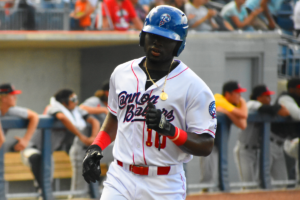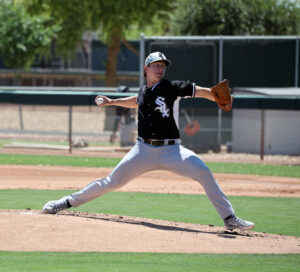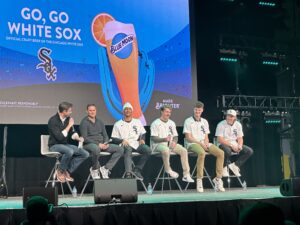The Improbable Path of Omar Narvaez
With the White Sox giving up Kevan Smith on the waiver wire, Omar Narvaez‘ listing on the 2019 Opening Day roster has gone from pencil to ink. It’s yet another achievement in a long line of improbable successes for the Major League catcher. Omar’s story of professional progression is one for the books.
A quiet start
Narvaez’ professional career began in 2008, when the Tampa Bay Rays signed him for a low six-figure bonus out of Venezuela at age 16. There is no indication he was on anyone’s prospect radar at that time, and his initial career progression does nothing to change that impression. He spent 2009 and 2010 with the Rays’ Venezuelan Summer League rookie affiliate, hitting in the low 300’s in both campaigns. The only thing that really stood out in his performance there was his K/BB ratio: in 2010 he had a 15.4% walk rate and struck out just 6.3% of the time.
2011 and 2012 saw Narvaez playing more rookie ball, but stateside in the Gulf Coast and Appalachian Leagues, where he was playing only about half the team’s games each season, and spending some of that time at first base. His numbers at the plate in 2011 were pretty meek (.221/.304/.250), but in 2012 he fared much better (.305/.380/.384) while playing around league-average age. He walked about as often as he struck out in both seasons. In 2013, Omar was promoted, but only a half-step up to the Short Season NY-Penn League. There he hit a pretty empty .267 and his walk rate – the shining light in his offensive game – fell to 4.9%.
So let’s take stock here. A low-bonus signee, Narvaez has spent five seasons in pro ball, and he’s not even reached a full season league. He has played just 222 games across those five seasons (and only 185 as a catcher), relegated to bench and platoon roles. One can look all over the interwebs and see nary a mention of the guy by this point, even from those following the Rays’ farm specifically. He’s shown no power or speed and mixed results as a hitter. This does not read like a prospect profile.
A bend in the road
Apparently the Rays agreed. After the 2013 season, Narvaez was eligible for the Rule 5 Draft. He was of course not added to the 40-man roster. He was not a legitimate risk to be selected in the Major League phase as no team would have selected him and tried to keep him on their active MLB roster for an entire season. He could have been protected from the Minor League phase though, had the Rays put him on their spacious MiLB reserve list. They did not. This is more or less a signal that the team’s own staff did not feel Narvaez was among even the top 50 to 70 prospects in the entire organization.
In December of 2013, the White Sox selected catcher Adrian Nieto in the MLB phase of the Rule 5 Draft. The unexpected move put Nieto on the team’s 25-man active roster for all of 2014 getting limited playing time as a backup, before heading down to AA in 2015 after his tuck-away year. He never returned to the majors.
But if you look at our coverage of that year’s Rule 5 Draft, you’ll find buried further down in the article that the Sox also picked up one Omar Narvaez in the AAA phase of the draft. I struggled to even squeeze two paragraphs out about the guy, as there was so little information available.
This is a good time to illustrate how rare it is for a player in Narvaez’ position at that time to even make the majors, let alone be a real contributor. I ran the numbers from the last 15 Rule 5 Drafts, looking at the Minor League phases only. Check out these numbers:
- Of the 583 players selected, just 41 (7%) reached the majors after being selected
- Of those 41 who did make it, only 21 (3.6% of total) managed to post a positive bWAR in MLB
- Of those 21, only 5 (less than 1% of total) have generated 3+ bWAR in their post-selection MLB careers
One of those five is Omar Narvaez, at 3.4 so far across 2+ seasons. For posterity, here are those five 3+ bWAR players:
- RHP Alexi Ogando, selected in 2005 and debuted in 2010: 9.4 WAR
- OF Alejandro de Aza, selected in 2004 and debuted in 2007: 7.1 WAR
- 1B Justin Bour, selected in 2013 and debuted in 2014: 4.7 WAR
- LHP Richard Bleier, selected in 2013 and debuted in 2016: 3.5 WAR
- C Omar Narvaez, selected in 2013 and debuted in 2016: 3.4 WAR
Of those 5, only Ogando and Narvaez had not yet played full season ball when selected, and Ogando has a bizarre back story involving position changes and fraud charges. One could argue Narvaez is truly one of a kind in his path. So how did Narvaez manage to join the 1% club?
Waiting in the Wings
Omar opened 2014 with Class A Kannapolis for his age 22 season, splitting time with org soldier Jeremy Dowdy. After putting up numbers that were becoming a trend for him – high average (.291), high contact rate (7.7% K/PA), and no power (.024 Iso) in 38 games – he was promoted mid-season to High-A Winston-Salem. There in another platoon arrangement his walk rate increased to a very pretty 15.5% (which was higher than his strikeout rate), and a little power began to emerge (Iso up to an even .100). But more important than the numbers, we started to get some in-person looks at him, our own and others. No speed in his game, but enough athleticism, and a decent arm.
In 2015 and having dropped switch-hitting, Narvaez repeated with the Dash and did Narvaez things in his age 23 campaign, though he did play in most of the team’s games. That was a first for him as a pro. Still under the radar, but we did put him on our “Just Missed” list outside our Top 30 in mid-season 2015, and then were the first site to rank him on their White Sox list. We put him at #25 on our January 2016 list, citing his elite plate discipline and defensive competence as the main drivers to his placement. It was a presage to what would happen next.
Launch Angle
After seven years of slow-rolling through the minors and getting scant attention as a prospect, the development of Omar Narvaez went from gradual to ballistic. On April 24th of 2016, an injury to White Sox catcher Alex Avila forced the promotion of Kevan Smith from the Knights to the Sox. Two days later, Smith himself was injured prior to what would have been his Major League debut, resulting then in Hector Sanchez heading to Chicago and leaving the Knights essentially without a catcher. So with just 13 games at AA, Narvaez was promoted to AAA. In early July, Avila was injured again and with Sanchez lost on waivers, the Sox promoted Narvaez to Chicago after just 41 games at AAA.
In seven years, Omar Narvaez had gone from rookie ball to high-A. It then took him just 4 months to go through three levels to the big leagues. Development is not linear, nor obviously are promotions.
In his debut MLB campaign, Omar did Omar things at the plate: hit for an OK average (.267), walked at a high clip (12% BB rate), made lots of contact (12% K rate) and didn’t show much power (.070 Iso). Nothing spectacular on the surface, but when you consider he’d been in A-ball less than a year prior, and the generally low bar for catcher offense, that’s a pretty darn successful debut. He did struggle with controlling the running game (runners were 23-for-25 in stealing attempts against him), though it was a small sample size as well.
In the two seasons since then with the White Sox, Narvaez’ bat has continued to develop and he put up one of the best offensive campaigns on the team regardless of position in 2018: .275/.366/.429, 9 HR (he hit just 7 HR in his minor league career). That’s above average for even a starting catcher in the bigs let alone a backup or platoon partner. His 122 wRC+ ranked 5th among MLB catchers in 2018.
Defensively though he’s shown some issues with both framing and plate blocking, while his running game control has been fringy but playable. Barring a dramatic leap in his glove work he’s not likely to be a starter going forward, but as a backup backstop his profile works, especially under relatively cheap control for another three years. And there is reason to believe he can improve a bit as a receiver – he is 26, not 36. He may also find himself some playing time at first base or even DH to further add value to the ballclub.
Every player has a development story, but few in MLB and likely no one on the Sox have one as improbable as Omar’s.
Want to know right away when we publish a new article? Type your email address in the box on the right-side bar (or at the bottom, if on a mobile device) and click the “create subscription” button. Our list is completely spam free, and you can opt out at any time.







